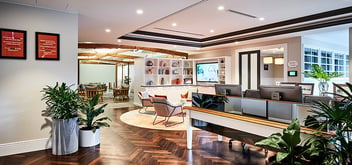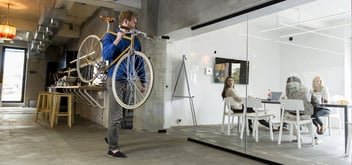Accurate and meaningful data is critical to making informed decisions about your workplace. Now, with the trend towards flexible working, the ability to understand how your space is being used and to accurately forecast future workplace requirements is essential for efficient workplace management.
It is also important to note that as there has been such a rapid change in the way people work, towards a ‘work from anywhere’ movement, organisational leaders are looking for strong evidence that helps them identify what their workplace should look like in the future, and what will drive employees to come back to the office and re-engage with the vision of the business.
Some of the region’s most strategic minds in workplace strategy came together for our webinar to demonstrate how data can be utilised to drive workplace change. Panelists included:
- Lisa Copland, Head of Workplace Strategy and Change at Presynct
- Jo-Anne Mann, GM and SVP Sales, Asia Pacific at SpaceIQ
- Peter Black, Workplace Strategist at Axiom Workplaces
- Steve Elliott, Head of Property and Facilities at QBE Insurance
Let’s go deeper into the discussion here, to understand how we can effectively gather and analyse workplace data, and use such insights to make better workplace decisions.
How COVID-19 changed the landscape
Working flexibly and remotely had already been present in many workplaces, prior to COVID-19, it had not really been culturally accepted.
Changes were slowly happening but it was accelerated as a result of last year. Flexible working became accepted and swiftly normalised. The stigma attached to it seemed to have disappeared overnight. Now tested and proven successful, the evidence that work still happened away from the office means employers need to be open to people working at home or remotely. Where companies once offered it but didn’t really support the cultural shift towards it, employees now expect flexible working as a permanent part of their employment. “No one cares about their desk anymore – they want flexible working instead,” says Lisa.
In fact, an in-webinar poll queried expectations for the average days in the office per week in the immediate future. Nearly 50% responded they expect 3-4 days in the office, and about 40% want only 1-2 days working on site. This clearly shows that flexible working is a majority preference, and that the future workplace will most likely remain a productive hybrid of working from home and at the office. Employers who don’t offer a flexible work practice risk losing a talent pool of great employees to other organisations who do, and will find it harder to attract great talent.
How organisations are gathering and analysing data
Steve Elliott shared how his organisation gathered data through utilisation studies. “We did it 6 weeks before COVID. What we lack now is data that is live and dynamic”. The company recently invested in a tool that allows them to gather data through the employee check-in process. Steve mentioned that this will provide them with daily data on the utilisation of the space and desks within the working environment.
Half of the webinar attendees seem to gather data in the same way. A second live poll demonstrated that around 50% of represented organisations measured the utilisation of space in the workplace (including desk and meeting room usage).
Peter Black identified the challenges for organisations today confirming it was tough gathering data during lockdowns. “We struggled with it because COVID is a big gap – a year at home means you don’t have data.” You have to look at historical data to base future projections on. So, while the environment was completely different, pre-pandemic data is still useful in determining the kinds of spaces employees occupy at different times of the day and week.
What decisions are being driven by data?
Right now, most workplace decisions rely on understanding people’s behaviour as they divide their time between working at home and in the office. By engaging in a workplace strategy piece where employees and leaders are asked what they require in order to complete their tasks, and simply observing employee actions – management can have a better view of what people do when they work in the office.
Currently, we are seeing a trend where employees use the physical workplace to connect and collaborate, then they work from home to engage in more focused tasks. This collaboration with employees enables leaders to identify which activities and projects are better done in the office or at home.
Steve also noted that “managers want to know when teams are coming in.” So, it’s important to get the data from people’s schedules to understand when they’re coming into the office or working remotely. Some employees book their schedules 2 weeks in advance. This data helps managers plan out support and other resources needed for each day. But as Jo-Anne pointed out, the information is not always accurate since “many people check-in, but don’t come in on the day.”
Another decision that’s driven by data is the actual space and number of desks needed for each day. This is where the utilisation data of desks and space comes into play. Of course, there will always be ‘peak days and peak floors’. People move desks and use different work spaces on the same day. And this can skew the utilisation figures. So can user error: ‘How many people check-in, but don’t come in?’, asks Jo-Anne Mann.
Both employers and employees are still adjusting to the new ways of working. So it can sometimes be difficult to get accurate data. Steve added that “We’re making decisions in the heat of a pandemic that won’t be here forever.” It’s essential to view the information from a bigger, more practical perspective.
What decisions SHOULD be driven by data?
We’ve seen how data is being used to plan daily activities and help make decisions on the amount of space or number desks needed each day. But the real value of data – where it can have a bigger and more profound impact on the organisation – can be seen when making future workplace decisions, and projecting into the future a working model for the organisation that can withstand changes in circumstances and variations in workflows.
How much change can we bring into the workplace? What headcount and how much growth can the current office space accommodate? To answer these questions, you need to look at the current and historical workplace data plus industry and market conditions. Plus, you need to explore and test out different scenarios.
Peter highlighted that organisations now have the “intention to grow without growing.” That is to grow revenue and profitability across the business but not growing in staff numbers. To do this, you need to look at automating and streamlining processes, plus outsourcing routine tasks. Many companies tend to overestimate the amount of office space they need. “It’s a better story to expand,” says Peter. “It’s easier to outgrow a smaller space then expand, than to have too much space to begin with.”
Companies are also able to add more spaces to innovate and socialise than before because when the data confirms they don’t need a desk for every employee, there is opportunity to introduce more variety of working environments within the same amount of space. This is something that may have been prohibited previously by budget and real estate costs.
In making future workplace decisions, It’s important to start by understanding the problem. What are you trying to achieve? The next step is to find and gather the relevant data. Then analyse and gain the insights to make the necessary decisions. But it is worth noting that different organisations have different drivers when it comes to analysing information and making decisions.
How can you redefine a space to create excitement about the office?
As businesses look toward a post-pandemic future and reopen offices, the biggest issue they need to deal with is encouraging people back to a physical workplace. Most employees are comfortable working from home and are not rushing back in. Employers need to redefine the workspace, and find ways to create a magnetic appeal for people to return to the office.
This is a common issue for many businesses, according to Peter. The office can sometimes feel like a morgue because nobody is there. You need to look at opportunities to “curate the office space.” Events, group work and mentoring opportunities – all these can bring the energy back to the workplace.
If there’s anything that people miss about the office, it’s the active vibe they feel when working with friends and colleagues. The experience cannot be like sitting on your desk on your own and just staring at your screen. You might as well work from home. Employees come to the workplace mainly to connect and collaborate. And a big empty space with rows of individual desks and people working in separate corners won’t help build that buzz or activity.
Steve suggested using data to determine the optimum size of the workspace you need for people to work together and create an energetic vibe – all, of course, within a COVID safe environment.
“Data, data, data. Clearly articulate with rich data. The rest will flow.” That is Steve’s last piece of advice. And it’s a statement that clearly highlights how your business can be better at making critical workplace decisions in the new world of work.
Want to learn more about futureproofing your workplace to ensure success and growth in the future? Read our guide to the future of work in Australia.






